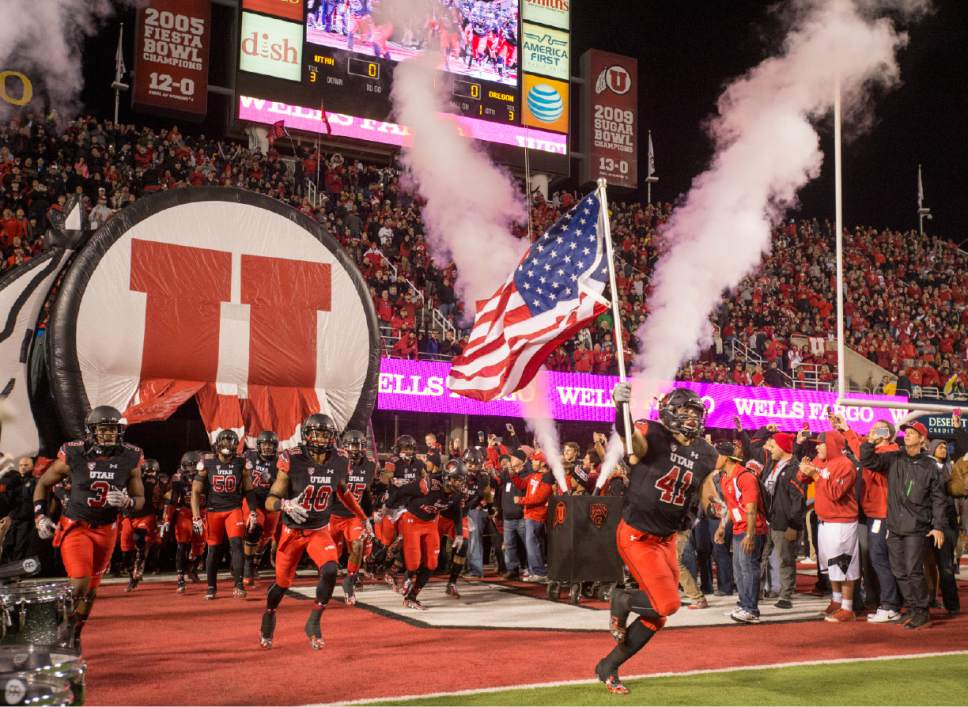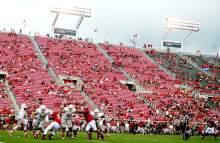This is an archived article that was published on sltrib.com in 2017, and information in the article may be outdated. It is provided only for personal research purposes and may not be reprinted.
The bigger the better? University of Utah athletics aims to find out.
On Monday morning, the department announced a university-led feasibility study for the expansion of Rice-Eccles Stadium — the top hot-button issue for a fan base that has sold out 38 consecutive home football games.
It's the first step in potentially adding seats to the 45,807-seat stadium, one of the smallest football venues in the Pac-12 Conference that has also cultivated a reputation as a tough place for visiting teams to play. Expansion hawks are among athletic director Chris Hill's most vocal critics, a group he hopes will be encouraged by the Utes getting a study rolling.
"I know it's something I very much want to get done, and it's one of the very top things fans want to talk about," he said. "I'm glad to take this step and no longer be the curmudgeon of nonexpansion."
The biggest impetus for the study is the state of the building in the southern end zone: One of the lesser-touched areas during the stadium construction in 1998, it now is a constant source of challenges. Many of the pipes in the building — which houses the team locker rooms, medical treatment areas and a media and donor meeting area — are leaky, and the university's facilities team must dig through concrete to access and repair malfunctioning equipment.
Senior CFO John Nixon said one of the building's pipes leaked badly in August 2015, the night before Utah was set to host its nationally televised season opener against Michigan under then-new coach Jim Harbaugh. Crews worked throughout the night to repair the leak, which was directly over the visiting coaches' locker room.
"It takes a lot of work because you can't just open your drywall and fix it," Nixon said. "Nobody knew about it at the time, and everything was fine for the game. But those are things we take care of on a regular basis."
Utah's aging facility in the southern end zone also creates logistical problems, particularly when the Utes try to host recruits and bring them into the locker room after games, Hill said. Utah football coach Kyle Whittingham has been a vocal proponent for years of closing off the bowl; the southern end zone is a free-standing building separate from the other sections of the stadium.
The time might be right for Utah football on several fronts. The department has had a 98 percent season ticket renewal rate each of the past seven years, and the team has won at least nine games in each of the past three seasons. The department's revenue has surged since its entry into the Pac-12 in 2010, surpassing $79 million in the past fiscal year.
The need to renovate the building will give Utah a chance to take a hard look at the market forces required to expand the stadium, a project that likely will cost tens of millions of dollars without the benefit of state or university funding. Utah athletics officials have funded a number of large projects, including football and basketball facilities, through private donations in recent years, and they hope to do the same with this project.
"There's a path where we want to have what is happening inside the stadium pay for what the renovation is going to be," Nixon said. "We need a strong financial plan so we don't wind up with a hole as some other universities have. There will be some bonding on it, but we've got have revenue to pay for that bond."
Hill said the study, which is projected to be completed in the next few months, will explore new avenues, updating a study the university conducted six years ago. Utah will look at luxury seating and lodges, as well as more economical seating options. Hill said he is not carrying any "preconceived notions" into the study, and the Utes have no target number of seats in mind.
The stadium is operated by the university, not the athletics department. Within the next few weeks, the university expects to have a committee that will include Nixon and Hill, and hire a consulting firm to do the study.
While the Utes are unlikely to enter a naming-rights deal on the stadium itself — as Utah State did in a $36 million renovation of Maverik Stadium last year — there could be other corporate sponsorship options, such as on the video board the school constructed last year. The Utes also hope to preserve the integrity of the 2002 Olympic Cauldron, which sits behind the building near the southern end zone.
While student-athlete amenities are the No. 1 factor in any renovation or expansion project, Hill said, the Utes hope to maintain a raucous home field atmosphere, which has helped the team go 13-6 at home in the past three seasons and get featured on ESPN's "College GameDay" in each of the past two seasons.
"We've obviously done a great job having a good team on the field, and we've been selling out for several years," Hill said. "We want to show our support of our football team, and they're in dire need of support in this area."
Twitter: @kylegoon









